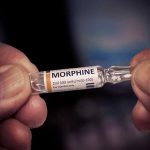Morphine is both an opioid and (more specifically) a naturally occurring opiate drug. It has been used to manage moderate and severe pain from the early 1800s to the present day.
Unfortunately, this potent pain management drug can rapidly produce physical dependence or addiction, and it is believed to have a potential for abuse similar to the illicit opioid drug heroin.
Opiate Vs. Opioid
Opioids make up a class of drugs all chemically related to naturally occurring pain relief substances found in the latex of the opium poppy plant, papaver somniferum. This means that opioid drugs include:
Opiates
These are natural substances harvested from opium, and include morphine, narcotine, codeine, thebaine, papaverine and narceine.
Semi-Synthetic opioids
These are drugs produced by modifying natural opiates in a laboratory, changing their properties, and increasing their potency. These drugs include hydromorphone, oxymorphone, hydrocodone, oxycodone (Oxycontin), and heroin.
Synthetic Opioids
While these drugs function like natural opiates, they are fully man-made in laboratories without the use of any naturally occurring base drugs. Synthetic opioids include fentanyl, methadone pethidine, levorphanol, methadone, tramadol, dextropropoxyphene, and others.
Morphine Brand Names
Morphine is available in oral tablets or capsules (immediate-release or extended-release), as well as suppositories, and injectable preparations to address moderate or chronic pain. Brand name medications containing morphine include:
- AVINza
- Kadian
- Kadian ER
- Morphabond
- MS Contin
- Oramorph SR
- Roxanol
- Roxanol-T
- Embeda (morphine sulfate and naltrexone hydrochloride)
Unfortunately, as with all opioid analgesics, morphine has a high potential for dependence and abuse, and those prescribing morphine should do so with care.
How Morphine Works
Morphine works like other prescription opioid pain medications, attaching to opioid receptors located throughout the central nervous system.
These receptors work with your body’s natural endogenous opioids, or endorphins. Opioid drugs like morphine are much stronger and block more pain while triggering artificial feelings of intense pleasure, comfort, and escape from stress and anxiety.
These euphoric feelings are why opioid abuse and opioid use disorder/opioid addiction are so common today, despite the long-term harms associated with opioid substance abuse.
Morphine Side Effects
Common side effects of opioids are generally similar across this entire family of drugs, and can include:
- headache
- dizziness
- lightheadedness
- mood changes
- constipation
Less common side effects of morphine use that should be reported to your healthcare provider include:
- agitation
- seizures
- fever, sweating, or chills
- muscle twitching
- changes in breathing
- nausea or vomiting
- sexual dysfunction
- itching, hives, or rash
Over time, morphine abuse can also trigger unpleasant withdrawal symptoms when you stop taking the drug, especially if you have abused morphine in high doses.
Morphine Overdose
The FDA includes a warning on all opioid medications, including those containing morphine, that using opioids in high doses or with other CNS depressants increases the risk of respiratory depression, sedation, and opioid overdose.
For this reason, opioid drugs should not be used with alcohol, benzodiazepines, muscle relaxants, and other drugs.
Signs and symptoms of a morphine overdose can include:
- shallow, slow, or irregular breathing
- nausea
- slow heartbeat
- blurred vision
- pinpoint pupils
- skin that feels cold to the touch or clammy
- muscle weakness
- drowsiness
- unconsciousness
If you suspect a morphine overdose has occurred, immediately administer naloxone, if available, and call your local emergency medical services to prevent overdose death.
To learn about our outpatient programs for opioid addiction, please contact us today.
Sources
Written by
Northeast Addition Editorial Team
©2024 Northeast Addition Center | All Rights Reserved
This page does not provide medical advice.




